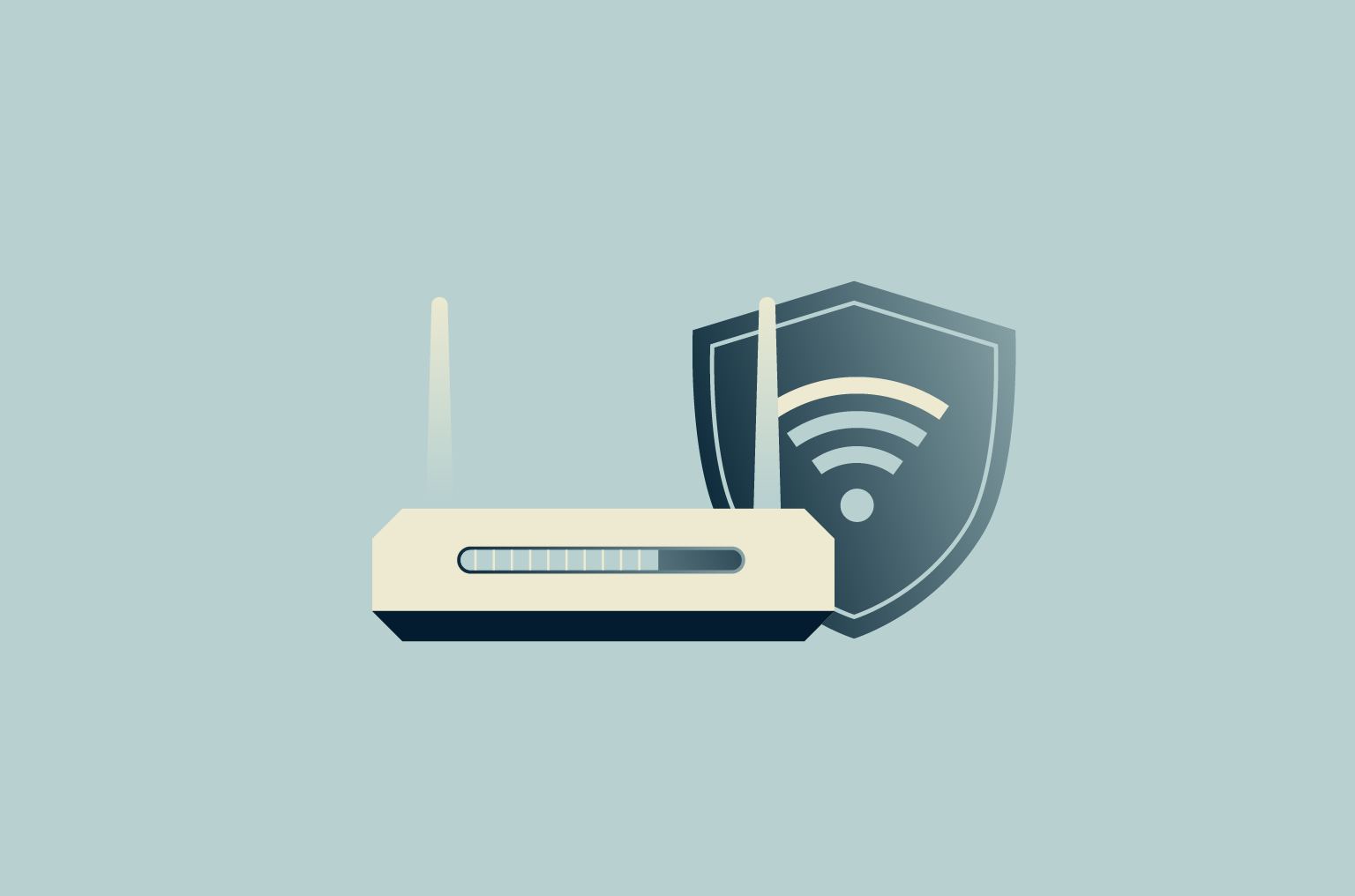How to install a VPN on a router (step-by-step guide)

VPNs aren’t just for laptops and smartphones. You can install them on a wide array of devices, including internet routers. There are many advantages to doing this, as a VPN-enabled router will protect your entire network and all of your devices simultaneously. However, the process of setting up a VPN on your router is a little different from setting it up on a phone or PC.
This guide explores how to install a VPN on a router, with a detailed step-by-step breakdown.
What is a VPN router?
The term “VPN router” refers to an internet router that has VPN software installed on it, so every device connecting to that router has the benefits of VPN protection. In the next sections, we’ll take a closer look at how this works and what it entails.
How a VPN router works
Setting up a VPN on a router works a lot like setting up a VPN on any other device. Once you’ve activated and enabled the VPN software, the router forms a secure connection with VPN servers. All traffic sent to and from that device becomes encrypted, and the device’s IP address and location are hidden. These benefits also apply to any and all devices that use that router to get online. That can include:
These benefits also apply to any and all devices that use that router to get online. That can include:
- Computers and laptops
- Smartphones and tablets
- Smart TVs
- Video game consoles
- Media streaming devices
Key features: Encryption, tunneling, and authentication
- Encryption: With a VPN router, all internet data traveling to and from the router will be encrypted. That means that the data will be jumbled up, appearing like a random series of letters and numbers to anyone who tries to intercept or access it.
- Tunneling: Your VPN will create a secure tunnel connection between your router and the VPN server. That allows the safe and secure flow of data from one end to the other, through that tunnel.
- Authentication: VPNs use complex authentication procedures to verify and maintain secure connections between your router and the VPN servers. At each end of the tunnel, various algorithms work to ensure that the connection remains stable and secure.
VPN protocols used in routers
VPN protocols are essentially like sets of rules that control how data is encrypted, transmitted, and authenticated over a VPN connection. Some are much safer and faster than others, with examples of leading protocols including Lightway, WireGuard, and OpenVPN.
Routers vary in terms of which protocols they’re able to support. Many models lack the necessary technology to support the latest and most advanced protocols and may instead only work with simpler options, like PPTP or L2TP.
Research your model to find out which protocols it works with. Or, if investing in a new one, make sure it works with the protocol you intend to use: some models, like the ExpressVPN Aircove, come preconfigured to work with modern, secure VPN protocols right out of the box.
Why use a VPN router?
There are numerous reasons to consider using a VPN router, including:
- For network-wide protection: A VPN router protects your entire home network. That includes all computers, phones, tablets, and smart devices that form that network. They all get the benefits of data encryption and IP masking.
- To save you time and hassle: If you’ve got a lot of devices, as many people do nowadays, it can be a hassle to set up VPN apps and connections on every single one. A VPN router saves you tons of time since you only have to set up the VPN once.
- To protect devices that don’t have VPN apps: Some devices, like smart TVs and video game consoles, may not have native VPN apps of their own. But, with a VPN router, you can bring VPN protection to any connected device.
- Safeguard as many devices as you need: Many VPNs have limits about how many devices you can install the software on. But if you install it on your router, you’ll be able to protect as many devices as you like, which is ideal for larger families and households.

Is your router VPN-compatible?
Before you worry about how to install a VPN on a router, there’s one initial question you need to answer: does your router actually support VPN connections? A lot of them do, but not all. Many consumer routers, for example, will work fine with VPN clients, but a lot of ISP-issued routers will not, and compatibility levels vary from model to model.
How to check compatibility
Fortunately, it’s not too difficult to confirm if your router is VPN-compatible or not. There are two quick and easy ways to find out:
- Google it: Search for your router’s make and model number, which you can usually find written on the router itself or the box it came in.
- Check the manual: If you have the user manual of your Wi-Fi router nearby, take a look through it. There should be a section detailing the router’s connection configuration options or VPN compatibility.
Types of routers that support a VPN
Routers can be categorized into four main groups. Here’s a look at each of those groups and whether or not they’re VPN-compatible:
- Consumer routers: These are routers you can buy in stores and set up at home or elsewhere. The majority of these routers should work with VPNs but may need some setting up in order to establish a VPN connection for the first time.
- ISP-issued routers: These are routers given to customers by internet service providers. A lot of the time, such routers are not VPN-ready, and some are even designed to restrict or block VPN usage.
- Custom firmware or preconfigured routers: These routers have been configured to work with VPN networks. They’ve already got the necessary software installed, making the setup process much easier for the end user, but this usually comes at a cost.
- VPN router boxes: As the name suggests, these routers are 100% VPN-compatible as they are designed to work with VPN software and protocols. They’re largely user-friendly and give you a lot of settings and control over your VPN connections and experiences.
How to add a VPN to your router
If you’ve verified that your router is VPN-compatible and want to enjoy the benefits of whole-home VPN protection through a VPN router, here’s how to set it all up. (Note that the steps below are general guidelines and may not apply exactly to your specific make or model of router.)
Step 1: Access router firmware
First, open your router’s admin or management page. To do this, you just have to open a web browser and type in the IP address for your router. The two most common addresses are 192.168.1.1 and 192.168.0.1, so it’s worth trying those first of all. If they don’t work, you may have to take some extra steps to find your router’s IP address.
Step 2: Find VPN configuration settings
Next, you need to dig into the menus and settings of your router to find the VPN settings. They will be in different locations for different routers but are often listed under Advanced, Security, or Network options. You may have to click around in the menus a little to find the correct page.
Step 3: Select a VPN provider
Do some research to compare options and then sign up for an account with your chosen provider. Note that some VPNs—like ExpressVPN—make it much easier to get set up on a router than others, as they will provide downloadable firmware packages and detailed installation guides for different makes and models of routers.
Step 4: Enable the VPN and enter credentials
Once you’ve obtained your VPN provider credentials and firmware settings, you can simply follow your provider’s guidelines and enter the relevant information in the VPN settings page of your router’s control panel. This may also involve uploading firmware files, if you have them, and your router may need to restart as part of the process. Once you’ve completed the setup, you should be able to activate your VPN and enter your login credentials to start a connection.
Step 5: Test the VPN connection
Finally, check to see if your VPN router is working. An easy way to do this is to visit a site that tells you your IP address, like ExpressVPN’s IP checker. If your VPN is working correctly, the address you see should be different from your usual home IP address.
What to do if your router doesn’t support VPNs
As stated earlier on, not all routers will work with VPNs. Some of them just don’t have the necessary software to set up VPN connections, and some are even specifically designed to restrict or prevent VPN usage. Fortunately, even if your router doesn’t natively support VPN connections, there are ways to work around that problem.
Flashing alternative firmware (DD-WRT, FreshTomato, OpenWRT)
Flashing firmware basically means replacing your router’s default software with alternative software that can support VPN connections. Various VPN-compatible firmware options exist, including free and open-source options like DD-WRT, FreshTomato, and OpenWRT.
To flash custom firmware for your router, you will need to:
- Choose which custom firmware you want to use and download the relevant files from a trusted source.
- Connect your router to your computer via an Ethernet cable.
- Boot your router into flashing mode and install the custom firmware.
- Configure your new firmware to support your chosen VPN client and protocol.
Be warned, however, that flashing custom firmware can void your router’s warranty and could cause various technical problems if you make any mistakes during the process. Flashing may also breach terms of service with some ISPs or router providers.
Using a DIY VPN router setup
Another option, best reserved for those with extensive technical expertise and experience, is to set up a DIY VPN router. You can essentially turn an old x86 PC into a VPN router by adding an extra network port to it and installing some custom firmware, such as pfSense and OPNsense. This won’t be a viable option for beginners, due to the complexity of the process, but can work well for those who know what they’re doing.
Expert tips for using a VPN router
Simply setting up a VPN on your router is just one part of the puzzle. To make the most of your VPN-enabled router, there are also certain best practices to follow and common mistakes to avoid.
Avoid double VPN coverage
Once you’ve got a VPN set up on your router, that means that any devices you connect via that router will have VPN protection. So, you don’t need to set up or run any additional VPN apps or software on those devices. In fact, it’s strongly recommended to not do so, as having a “double VPN” connection via your device and router could cause your speeds to drop significantly.
To avoid this issue, just use the VPN on the router and only use VPN software on your individual devices when connecting to other networks, like public Wi-Fi hotspots.
Bookmark router admin page
Unlike your favorite websites, you probably don’t visit your router’s admin page in your web browser too often, so you might forget the exact combination of numbers needed to access it. Many people end up wasting time googling how to find their router’s admin page or looking through the instruction manual to find the exact IP address they need to type in.
To avoid all of that hassle and be able to access your router’s admin page at any point, bookmark it in your browser of choice.
Update firmware regularly
Just like phones and computers, many routers receive regular firmware updates. These updates provide numerous benefits, like fixes for any security weaknesses or performance enhancements to help with connection speeds and stability. In other words, they’re important, and it’s best to install any updates as soon as they become available.
If you persist with old, outdated firmware, you may not get the best levels of performance or the highest standards of security. Enable automatic updates on your router, if possible, to ensure you never miss them.
Bonus: Why choose the Aircove VPN router?
If you’d like to enjoy the full advantages of a VPN-enabled router, consider ExpressVPN’s own Aircove VPN router range. Designed by our security experts, Aircove Wi-Fi 6 routers feature built-in VPN technology, providing all the benefits of ExpressVPN’s vast and secure VPN server network to all of your devices in an easy, convenient, and beginner-friendly way.
Top benefits
- Easy setup: While it can be tricky to set up VPNs on some routers, that’s not the case with Aircove. All the software you need is already installed, making setup a quick and easy procedure.
- Full-home VPN coverage: Enjoy the benefits of Aircove’s advanced protection across all devices in your home. That includes smartphones, computers, laptops, smart TVs, consoles, and more.
- Threat protection and auto updates: Thanks to its built-in Threat Manager feature, Aircove can help you stay safe from malicious sites and services. Plus, the router automatically updates to keep security and performance levels consistently high.
Aircove Go—travel-friendly VPN router
For frequent travelers or those who are often on the move, the Aircove Go takes the technology of the Aircove and packs it into a compact, portable router you can take almost anywhere. Small enough to fit in your palm, this router is perfect for enjoying the security and privacy benefits of ExpressVPN while connecting to public Wi-Fi in places like hotels, airports, and so on.
FAQ: Common questions about how to install a VPN on a router
Should I put a VPN on my router?
It’s certainly a good idea to do so, yes, as it will allow you to enjoy complete VPN protection across your entire network. That means any internet-connected devices that use your router to get online will be protected and hidden from any trackers or prying eyes.
Do all routers support VPNs?
No, not all routers will work with VPNs, and even on those that are VPN-compatible, setup methods vary, and it can require quite a lot of work to get the VPN up and running. You can check to see if your router is VPN-compatible by researching it online or reading the manual.
Can I use a VPN on Xfinity or ISP-rented routers?
It depends on the model, but most ISP-rented routers, including Xfinity models, are not designed to support VPN connections natively. You’ll have to check your specific model to see if it’s compatible, and if it’s not, you may have to simply use VPN software on individual devices rather than trying to set it up on the router itself.
How to set up a VPN on a 4G router?
It depends on the exact model of router you have. Usually, you’ll need to access your router’s admin or management page, find the VPN settings, select a VPN provider and protocol, enter the relevant details, and then enable the VPN connection.
How do I add a VPN to my network?
To add a VPN to your whole network, you’ll want to set up the VPN connection on your router. That way, any devices connected to the router will have VPN protection. To do this, you usually need to access your router’s admin page, find the VPN settings, enter the relevant VPN data from your provider, and then activate the connection.
Can I put a VPN on my ISP router?
It depends on which ISP you have and what model of router you’re using. Some of them support VPN software, but others don’t, so it’s a question of checking your router’s compatibility to find out if it’s possible or not. If it is, you can set up your VPN via the router’s admin or management menu. If not, you’ll have to explore other options, like using VPN apps on individual devices.
How do I know if my router supports a VPN?
An easy way to check if your router supports VPN is to simply find the model number, which is usually listed on the device itself, and then Google it. There are various online resources that can tell you if your router is VPN-compatible. Alternatively, you can check the user manual that came with your router, which should also provide information about VPN connections.
Take the first step to protect yourself online. Try ExpressVPN risk-free.
Get ExpressVPN






